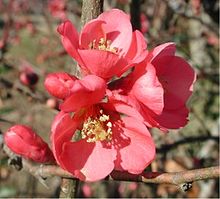| Chaenomeles | |
|---|---|

| |
| Chaenomeles in flower, probably a cultivar of C. × superba | |
| Scientific classification | |
| Kingdom: | Plantae |
| Clade: | Tracheophytes |
| Clade: | Angiosperms |
| Clade: | Eudicots |
| Clade: | Rosids |
| Order: | Rosales |
| Family: | Rosaceae |
| Subfamily: | Amygdaloideae |
| Tribe: | Maleae |
| Subtribe: | Malinae |
| Genus: | Chaenomeles Lindl. |
| Species | |
|
Chaenomeles cathayensis | |
Chaenomeles is a genus of four species[1] of deciduous spiny shrubs, usually 1–3 m tall, in the family Rosaceae. They are native to Southeast Asia. These plants are related to the quince (Cydonia oblonga) and the Chinese quince (Pseudocydonia sinensis), differing in the serrated leaves that lack fuzz, and in the flowers, borne in clusters, having deciduous sepals and styles that are connate at the base.
The leaves are alternately arranged, simple, and have a serrated margin. The flowers are 3–4.5 cm diameter, with five petals, and are usually bright orange-red, but can be white or pink; flowering is in late winter or early spring. The fruit is a pome with five carpels; it ripens in late autumn.
Chaenomeles is used as a food plant by the larvae of some Lepidoptera species including the brown-tail and the leaf-miner Bucculatrix pomifoliella.